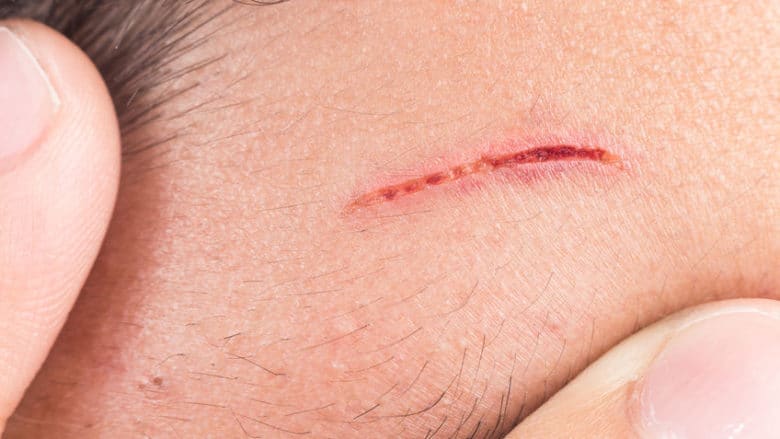
Natural wound healing is quite the marvel. Your body knows how to heal—“you” know how to heal. I say “you” because you are more than your body—you are whole: body, mind, and spirit.
You feel, you think, you sense, you just know things. You are a part of something beyond your self—your family, friends; your environment including the food you eat, the air you breathe, and the sun’s light.
You are a part of something greater than your self—God, universal life force, Great Spirit, Yahweh, Allah, the natural order of life, whatever words you use.
The word “heal” is from the old Anglo-Saxon word “haelan” that means to make whole.
When injured, all these aspects of your self contribute to natural wound healing in order to return your body to its wholeness. For example, this happens all the way from the sun’s light that your skin uses to create vitamin D to the workings of the smallest structural unit of your body—your cells.
Your cells carry an intelligence that knows what to do when injured. Scientists call it the healing cascade.
Natural Wound Healing:
The Healing Cascade
An injury sets into play a sequence of events that flows through three phases: inflammatory, proliferative, and remodeling.
The first phase (inflammatory phase) starts the moment of cell injury. The damaged cells sound the alarm, immediately increasing blood flow and triggering movement of specialized cells to the injury site.
These specialized cells send chemical signals igniting the healing response and calling in cells that control bleeding and cells that prevent the further loss of important substances from the cells.
Other cells start cleaning up the site by gobbling up non-functioning cells, bacteria, and damaged components.
Another type of cell releases substances that cause the surrounding vessels to become leaky, allowing immune cells to move into the area. Fluid accumulates at the site and the characteristic signs of inflammation occur— redness, heat, swelling, and pain.
The second phase (proliferation phase) begins within forty-eight hours. Depending on the injury, it may last up to six weeks. In this phase, the cleanup continues and specialized cells continue to flow into the area.
The predominant cell now is the fibroblast. Fibroblasts produce the new connective tissue needed to restore function to the injured tissue. Other factors come into play to form collagen (a whitish substance that makes up connective tissue). As the collagen matures, it becomes stronger and stronger.
The third phase (remodeling phase) occurs within eight weeks. In this phase, collagen grows thicker and denser, becoming stronger and stronger. The healing process completes and the symptoms subside. As the tissues age and strengthen they also shrink, returning them to their normal strength and length.
Natural Wound Healing:
A Holistic Approach
Use your whole being to work with, not against, natural wound healing.
- Call on Your SpiritTake a few deep breaths and send love to the area. Your mother may have instinctively done this when she held you when injured. You can also send healing energy to the area by using methods like Reiki, Therapeutic Touch, or creative visualization.
- Calm Your MindAllow your deep breaths to calm and relax you. A calm mind can think clearly, it helps release of the healing substances of mind body healing.
- Support Your Body’s Natural HealingFollow the steps in the “Cuts and Scrapes: 7 Steps for Natural Healing” article. Depending on the type of injury, consider natural substances to ease pain and promote healing:
- Witch Hazel (acts as an astringent for minor cuts and scrapes)
- Aloe Vera (helps burns and minor wounds)
- Arnica (helps bruises and muscle/joint pain)
- Bromelain (reduces swelling and helps pain)
- Honey (helps burns)
Nourish your cells with healthy foods:
- Eat more antioxidant-rich foods, including fruits and vegetables and whole grains (versus processed foods).
- Include omega-3 fatty acids like Wild Alaskan salmon or freshly ground flax seeds.
- Drink lots of water to keep the skin hydrated and healthy.
- Avoid refined sugars including soft drinks and sweetened juices.
Key Points
Your body knows how to heal. “You” know how to heal. Use these 3 tips to enroll your whole being — body, mind, and spirit in your natural healing. Work with, not against, natural wound healing.
Sources and Resources
DailyMed, WitchHazel Liguid, May, 2011, http://dailymed.nlm.nih.gov/dailymed/drugInfo.cfm?id=43086#nlm34089-3.
Ehrlich, Steven, “Arnica,” University of Maryland Medical Center website, http://www.umm.edu/altmed/articles/arnica-000222.htm.
Family Doctor.org, “Cut, Scrapes, and Stitches,” December, 2010, http://familydoctor.org/online/famdocen/home/healthy/firstaid/after-injury/041.html.
Mayo Clinic, “Cuts and Scrapes: First Aid, November, 2009, http://www.mayoclinic.com/health/first-aid-cuts/FA00042.
Molan, Peter, “Honey as a Topical Antibacterial Agent for Treatment of Infected Wounds,” World Wide Wounds, December, 2001, http://www.worldwidewounds.com/2001/november/Molan/honey-as-topical-agent.html.
Moore, Nancy, The Cure for Chronic Pain: End the Pain of Arthritis, Sports Injury, and Other Joint Problems (Peoria, AZ: Intermedia, 2009).
National Center for Complementary and Alternative Medicine, “Herbs at a Glance: Aloe Vera,” April, 2011, http://nccam.nih.gov/health/aloevera.
